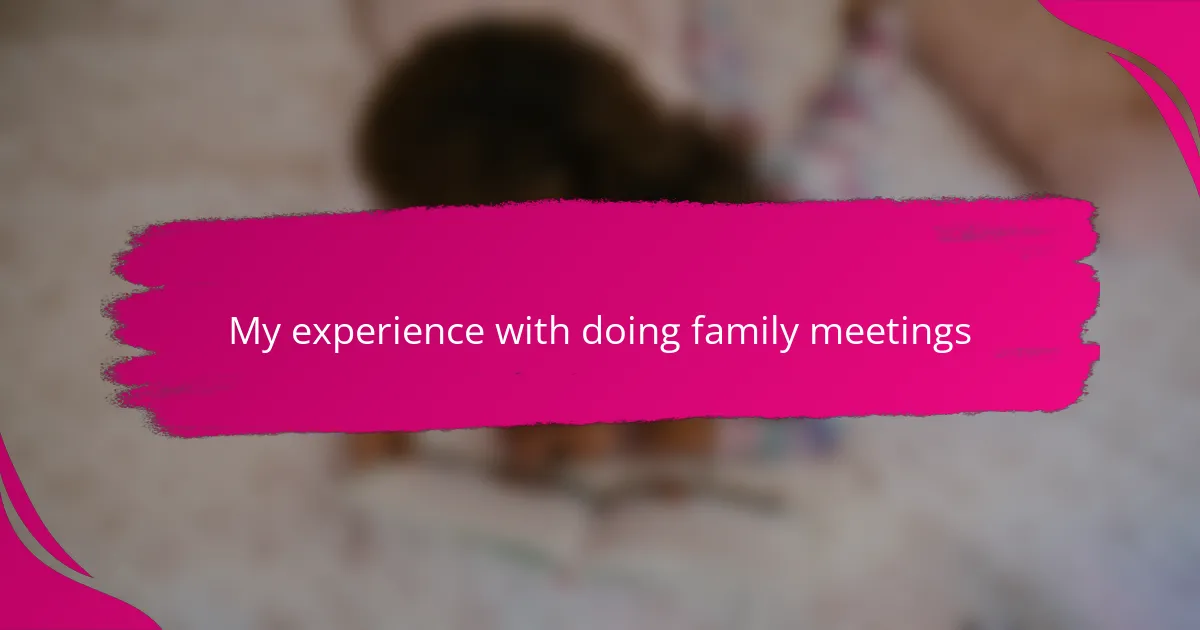Key takeaways
- Family meetings create a supportive environment for open communication, allowing all family members to share thoughts and feelings.
- Implementing techniques like a “talking stick” and starting with a “high and low” round fosters active listening and empathy.
- Maintaining brevity and setting simple ground rules encourages participation and keeps meetings enjoyable.
- Ending meetings on a positive note enhances connection and reinforces family bonds, making members look forward to future gatherings.

What Are Family Meetings
Family meetings are simply dedicated times when everyone in the household comes together to talk about important things. From my experience, these gatherings feel like a safe space where each family member gets to share their thoughts and feelings without interruption. Have you ever noticed how much easier it becomes to tackle problems when you all listen to each other?
What’s interesting is that family meetings don’t have to be formal or lengthy. In my home, they often start with everyone grabbing a snack and sitting around the kitchen table casually. This relaxed atmosphere makes it easier to open up and discuss both big decisions and small victories.
I’ve found that these meetings become moments of connection amidst busy schedules. They’re not just about planning or rules but about understanding each other better. When was the last time your family truly checked in with one another like this?

Benefits of Family Meetings
One of the biggest benefits I’ve noticed is how family meetings create a space where everyone feels heard. It’s amazing how just a few minutes of focused attention can make a child feel valued and boost their confidence. Have you ever seen a shy family member suddenly light up when their idea is taken seriously?
Another thing I appreciate is how these meetings help us solve conflicts before they grow. When my kids argue over small things, a quick family chat often reveals hidden frustrations or misunderstandings. It saves us from those longer, more stressful disagreements later on.
Finally, I believe family meetings strengthen our bond in ways I hadn’t expected. Sharing our highs and lows turns routine evenings into meaningful moments. Isn’t it rewarding to witness your family not just coexisting, but truly connecting?

How to Set Up Family Meetings
The first step I took in setting up family meetings was choosing a day and time that worked for everyone. It wasn’t always easy juggling different schedules, but we agreed on a time when the house was calm—usually after dinner. Have you tried picking moments that feel natural rather than forced? That made a big difference for us.
I like to keep the setting informal, often just gathering around the kitchen table with a cup of tea or a little snack. Creating a relaxed environment signals to everyone that this isn’t a chore but a chance to connect. When you make the space inviting, do you notice how family members seem more willing to share?
One tip I learned along the way is to set a simple agenda or theme before the meeting starts—nothing strict, just a few points to guide the conversation. For example, sometimes we focus on planning upcoming events, other times on sharing feelings or solving a problem. Does having a gentle structure help your family stay on track without feeling rigid? It certainly helped ours stay productive and respectful.

Effective Family Meeting Techniques
One technique that truly transformed our family meetings was using a “talking stick” approach—only the person holding a designated item could speak. It might sound simple, but this little rule helped us listen more carefully and interrupted far less. Have you noticed how easy it is for kids and adults alike to jump in before someone’s finished? This method gave everyone a fair chance to express themselves without feeling rushed.
I also found that starting with a “high and low” round—where each person shares one good thing and one challenge from their week—sets a tone of openness and empathy. It breaks the ice and invites honesty without pressure. When we first tried this, I was surprised by how much more connected we felt afterwards. Isn’t it amazing how sharing small moments can build deeper understanding?
Lastly, I learned to encourage solutions rather than just complaints by asking questions like, “What can we try differently?” instead of dwelling on problems. This shift sparked creativity and turned meetings into collaborative problem-solving sessions. Do you think your family could benefit from a mindset that focuses on possibilities instead of setbacks? From my experience, it makes these gatherings not just productive but hopeful.

Challenges Faced During Family Meetings
Sometimes, getting everyone to actually speak up is tougher than I expected. Kids, in particular, sometimes clam up or get distracted, making it hard to hear their true feelings. Have you ever sat in a meeting where the silence feels louder than the words? I’ve been there, wondering how to draw out those quiet voices without pressuring them.
Another challenge I faced was managing emotions that ran high during certain topics. Family meetings are meant to be safe spaces, but feelings can flare, especially when disagreements surface. I remember one meeting turning unexpectedly tense over a simple chore schedule—reminding me that patience and gentle guidance are key. How do you stay calm when the conversation heats up?
Lastly, keeping the meetings consistent was a struggle at times. Life gets busy, and skipping a meeting seemed harmless until topics piled up, causing frustration. I learned it’s better to keep meetings short and sweet, rather than skipping altogether. Have you noticed how skipping one chat can lead to bigger misunderstandings later on? This juggling act is part of the process, and it keeps us learning together.

Personal Experience With Family Meetings
In my experience, the first few family meetings felt a bit awkward—like breaking the ice was harder than I anticipated. I remember one evening when my usually talkative daughter barely said a word, and it made me realize that creating a truly safe space takes time and patience. Have you ever noticed how some family members need just a little extra encouragement before they open up?
Over time, these meetings became moments I genuinely looked forward to, especially when I noticed my son sharing his frustrations instead of bottling them up. It was rewarding—and honestly a relief—to see communication improve, reducing the tension that used to linger after a long day. Doesn’t it feel good when a simple conversation can clear the air?
Of course, not every meeting went perfectly. I recall one where emotions ran so high that we had to pause and step back to cool down, teaching me the importance of pacing and sensitivity. These experiences helped me understand that family meetings are as much about learning to listen and adapt as they are about solving problems. How do you handle those tough moments when emotions get raw? For me, it’s all about staying calm and remembering we’re all on the same team.

Tips for Successful Family Meetings
One tip that really helped us was to keep family meetings short and sweet. I learned quickly that dragging conversations on too long made everyone restless—especially the kids. Have you ever noticed how attention drops after just a few minutes? Keeping it brief keeps the energy up and makes each meeting something to look forward to.
I also found that setting clear but simple ground rules made a huge difference. For example, agreeing to listen without interrupting created a respectful vibe that encouraged honest sharing. When everyone knows the expectations, it’s easier to stay calm, even when tough topics come up. Have you tried this? It might sound basic, but it really shaped how our family communicates.
Another tip I swear by is ending meetings on a positive note—sometimes by sharing something everyone’s grateful for or a small family win from the week. It shifts the focus from problems to connection. Doesn’t it feel good to wrap up on a high, with everyone leaving the room a little happier? I’ve noticed this simple practice strengthens trust and keeps us coming back for more.
